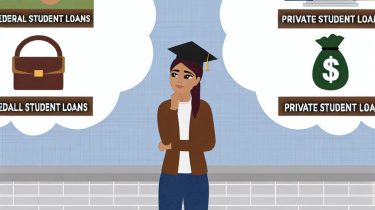Differences between federal and private student loans.

Understanding Federal and Private Student Loans
Students looking to finance their education often face the decision between choosing federal or private student loans. While both types of loans have the primary aim of assisting students with their educational expenses, they possess distinct characteristics, advantages, and potential disadvantages. Understanding these differences is vital for making informed financial choices.
Source of Funding
Federal student loans derive their funding from the U.S. Department of Education. This option includes a clear and structured application process mainly managed through the Free Application for Federal Student Aid, commonly known as the FAFSA. This process assesses a student’s financial need and eligibility for various federal aid options.
On the other hand, private student loans come from private entities, including banks, credit unions, and online lending services. The application process for these loans is not uniform, as each lending institution has its own criteria and procedures for evaluating and approving loans. As a result, students might experience varying application and approval experiences based on the lender they choose.
Interest Rates and Fees
A significant distinction between federal and private student loans is the interest rates. Federal student loans offer fixed interest rates set by Congress, ensuring the rate remains constant for the entirety of the loan. Often, these rates are more favorable compared to private loan rates.
In contrast, private student loans can have either fixed or variable interest rates. Variable rates change according to market conditions, which can increase significantly over time, affecting the overall cost of the loan. Therefore, understanding the differences between fixed and variable rates and their implications on long-term repayment is crucial.
Furthermore, federal loans often have minimal to no origination fees, making them more cost-effective. In contrast, private lenders may impose initial fees like origination fees and other administrative charges, which can increase the total borrowing cost significantly.
Repayment Options
Another area where federal and private student loans differ substantially is in repayment options. Federal student loans provide a broad array of repayment plans designed to accommodate various financial circumstances and needs. Options include a standard repayment plan and several income-driven repayment plans that adjust monthly payments based on your income and family size. Additionally, specific programs like the Public Service Loan Forgiveness (PSLF) offer unique repayment benefits to eligible borrowers working in designated public service areas.
Private student loans generally offer fewer repayment options. Some private lenders provide options for deferment or forbearance but typically lack the flexibility and variety of federal repayment plans. Therefore, borrowers must carefully assess their financial situations and potential changes over time when choosing between federal and private loans.
Credit Requirements
Federal student loans are more accessible as they do not require a credit check, with the exception of PLUS loans. This feature allows a broad range of students to secure federal loans regardless of their credit history. In contrast, private lenders evaluate the borrower’s creditworthiness to determine eligibility. This often results in the need for a co-signer for students who have limited credit history or lower credit scores. Understanding the implications of this requirement is important, as a co-signer is legally responsible for loan repayment if the primary borrower cannot meet their obligations.
Loan Forgiveness and Cancellation
Federal student loans possess advantages like loan forgiveness and cancellation under specific conditions. Programs such as the Public Service Loan Forgiveness and Teacher Loan Forgiveness provide paths to reduce or eliminate federal loan debt for eligible individuals. These programs are targeted at borrowers who meet certain criteria, often related to their employment sector or service duration.
In contrast, private student loans seldom offer similar opportunities for forgiveness or cancellation. As such, understanding the potential for loan forgiveness is essential for making informed decisions about borrowing, especially for students planning careers in public service or nonprofit organizations.
Application Process
Applying for federal student loans is a standardized process centered around submitting the FAFSA. This application assesses eligibility for various types of federal financial aid, encompassing loans, grants, and work-study opportunities. The streamlined structure of the FAFSA makes it easier for students to navigate available options based on their financial needs.
Conversely, applying for private student loans involves diverse requirements, which differ across lenders. Each private lender has unique criteria and documentation requirements for evaluating loan applications. This process typically demands comprehensive personal and financial information to assess the applicant’s creditworthiness and ability to repay the loan.
For further information, students can explore detailed guides on federal student loans or delve into different private lender options through resources such as the Consumer Financial Protection Bureau. Navigating these choices effectively requires an understanding of the differences between federal and private student loans to align educational financing with long-term financial well-being.
This article was last updated on: February 10, 2025